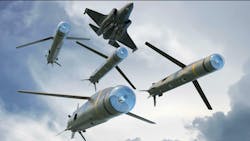Raytheon to stave-off component obsolescence in StormBreaker multimode seeker-equipped air-to-ground missiles
EGLIN AIR FORCE BASE, Fla. – Smart munitions designers at Raytheon Technologies Corp. will produce, upgrade, and maintain U.S. Air Force radar- and infrared-guided air-to-ground missiles under terms of a potential $75 million order announced Monday.
Officials of the Air Force Life Cycle Management Center at Eglin Air Force Base, Fla., are asking the Raytheon Missiles & Defense segment in Tucson, Ariz., for Small Diameter Bomb II Life Cycle Support Contract III for all versions of the GBU-53 StormBreaker Small-Diameter Bomb.
Support includes engineering and manufacturing development integration, production, sustainment, testing, obsolescence analysis and management, logistics support, testing, training, upgrades, and software updates.
Raytheon also will provide upgrade studies and analysis, simulations, modeling, test hardware, aircraft integration, procurement of test hardware, engineering, management fielding, and logistics for future growth requirements.
Like the GPS-guided GBU-39 SDB I already integrated on the F-35 joint strike fighter, the 208-pound StormBreaker is six to seven inches in diameter. This size can fit eight StormBreaker munitions in the F-35’s confined internal weapon bays.
If stealth is not a factor, about 16 more can fit on the F-35's wings. The munition also is approved for use on the Navy the F/A-18E/F Super Hornet carrier-based jet fighter-bomber and Air Force F-15E jet fighter-bomber.
The StormBreaker air-to-ground smart weapon with multimode seeker can hit moving targets in bad weather. The winged munition autonomously detects and classifies moving targets in darkness, rain, fog, smoke or dust.
The tri-mode seekers share targeting information among all three modes to engage fixed or moving targets any time, and in any weather. The weapon can also fly more than 45 miles to strike mobile targets. The total cumulative face value of the Small Diameter Bomb II Life Cycle Support Contract III contract is $275 million.
The smart munition for guidance uses millimeter wave active radar homing, semi-active laser guidance, infrared homing with an uncooled imaging infrared camera, GPS-coupled inertial guidance, and radio data-links back to the aircraft.
Its millimeter wave radar detects and tracks targets through weather; imaging infrared provides enhanced target discrimination; and its semi-active laser enables the weapon to track a laser designator on the aircraft, or on the ground.
On this order Raytheon will do the work in Tucson, Ariz., and should be finished by September 2024. For more information contact Raytheon Missiles & Defense online at www.raytheonmissilesanddefense.com, or the Air Force Life Cycle Management Center at www.aflcmc.af.mil.
About the Author
John Keller
Editor-in-Chief
John Keller is the Editor-in-Chief, Military & Aerospace Electronics Magazine--provides extensive coverage and analysis of enabling electronics and optoelectronic technologies in military, space and commercial aviation applications. John has been a member of the Military & Aerospace Electronics staff since 1989 and chief editor since 1995.
